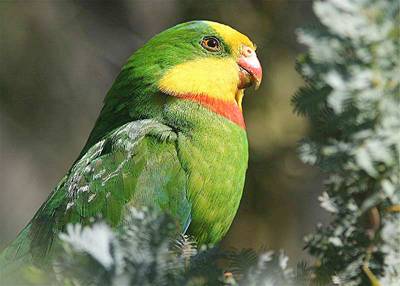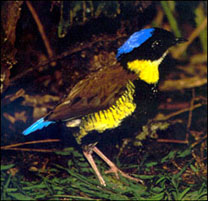Birds in the News #23

Globally-threatened Superb Parrot, Polytelis swainsonii.
Native to Australia where it nests in red gum trees.
Photo by Geoffrey Dabb.
People Helping Birds:
The biggest annual ornithological meeting in the country, American Ornithologists' Union (AOU), convenes this coming week at the University of California, Santa Barbara on Tuesday through Saturday, August 23 to 27. Highlights include a public presentation on the rediscovery of the ivory-billed woodpecker, Campephilus principalis, in the forest swamps of Eastern Arkansas (8pm, Thursday, August 25) and a discussion another bird of great interest to the public, the California condor, Gymnogyps californianus, entitled "Endangered Species Recovery: the California Condor as a Model" (beginning at 8:30am, Saturday, August 27). The AOU is the oldest and largest organization in the Western Hemisphere that is devoted to the scientific study of birds. Although AOU is primarily a professional organization, its membership of approximately 4,000 includes a number of amateur bird watchers who dedicated to the advancement of ornithological science. Thanks to the AOU meeting, next week's Birds in the News will be crammed with all sorts of fun and interesting bird news because everyone who is anyone will be there, talking about birds.
The World Parrot Trust, the UK-based organization founded by Mike Reynolds in 1989 and now headed by ornithologist Jamie Gilardi, is spearheading an effort to persuade the European Union to enact a trade ban on wild-caught birds. A European Union trade ban is needed because, despite export controls and other efforts to control trade in wild-caught birds, there are still massive numbers of wild-caught birds being poached from the wild for sale, and Europe is a large market for these birds. Europe represents 93% of the market for CITES-listed birds and 90% of the global market for wild-caught birds. Each year, roughly one million birds are taken from the wild for legal sale in Europe; no one knows the extent of the illegal trade. Overall, it is estimated that four million birds are taken from the wild for the European trade but half die before reaching the market. Parrots, songbirds, waterbirds, and raptors - all are part of this tragedy that threatens the survival of wild bird populations. If you would like to help, go to birds are for watching, where you can sign an online petition, donate money and learn more about the wild bird trade. Cessation of the trade in wild-caught birds is essential to protect not only the wild populations of those birds, but also to protect the wild birds of Europe from disease.
 Visitors to Britain’s biggest bird event – the 17th annual British Birdwatching Fair will help to save spectacular Jewel-thrush, also known as Gurney's Pitta, Pitta gurneyi. The Gurney’s Pitta (pictured) is a brilliantly coloured, but secretive bird of the forest floor. Only known from peninsular Thailand and adjacent southern Myanmar, there are approximately 20 pairs now known to still exist. The Birdfair will raise funds to establish protected areas in the lowland forests where the pitta occurs, as well as training and employing conservation staff and assisting local wildlife NGOs in their conservation work with the species.
Visitors to Britain’s biggest bird event – the 17th annual British Birdwatching Fair will help to save spectacular Jewel-thrush, also known as Gurney's Pitta, Pitta gurneyi. The Gurney’s Pitta (pictured) is a brilliantly coloured, but secretive bird of the forest floor. Only known from peninsular Thailand and adjacent southern Myanmar, there are approximately 20 pairs now known to still exist. The Birdfair will raise funds to establish protected areas in the lowland forests where the pitta occurs, as well as training and employing conservation staff and assisting local wildlife NGOs in their conservation work with the species.People Hurting Birds:
In Australia, logging has devastated more than half of an endangered native bird's protected nesting colony because of a bureaucratic bungle by the Department of Sustainability and Environment. "The logging operation intruded into the protection zone for superb parrots, because that (protection zone) hadn't been recorded in the Coupe Information System, and the forestry officer who would normally have known to check the maps was away ill," Kevin Ritchie, department's Northeast regional director, said. As few as 150 superb parrots, Polytelis swainsonii, still breed in Victoria, in a handful of nesting colonies around the Barmah State Forest near Echuca. Needless to say, there are plenty of protesters who are calling for a complete moratorium on logging in the Barmah State Forest. Adding insult to injury, the logged trees were used for firewood or, as the first linked news story notes, were left behind on the forest floor to rot.
Good Bird News:
BBC News reports that this year is a good one for the barn owl, Tyto alba. Scientists said the successful barn owl season was linked to a good crop of fruit and seeds last season. "Last winter there was an exceptional glut of wild fruits, including beech mast and haws, which was great news for these mammals," said British Trust for Ornithology research biologist Dave Glue. "The rodents [that ate these fruits] in turn provide a ready food supply for barn owls." This story includes video.
Ivory-billed Woodpecker News:
Are you a good birder who has time to chase the IBWO? If so, the Cornell Laboratory of Ornithology is looking for you! They have 15 job openings for 4 positions to staff the search for IBWO between 31 Oct 2005 and 31 April 2006 in Arkansas. They are seeking anyone with excellent field skills (especially birding) to apply! These jobs can be viewed on Cornell's online job board, at Texas A&M's wildlife and fisheries sciences job board, the Society for Conservation Biology's job board, or on the Ornithological Societies of North America's job board.
Birds in the Media:
Featured this week on BirdNote are Chickadees at Dawn; the Caspian tern, Sterna caspia -- Scapegoat; The Gulls of Summer; Common Nighthawk, Chordeiles minor (a rerun); and Snowy Egrets, Egretta thula, Killer Hats. This last show also announces the opening of a new exhibit at the Washington State History Museum in Tacoma, "Birds on the Brink -- Killer Hats." This exhibit explains the feather trade of the late 1800s and early 1900s, which spawned many conservation organizations, including what eventually became the Audubon Society. BirdNote can be heard Monday through Friday, 8:58-9:00AM, throughout Western Washington and Southwest British Columbia and is also available as RSS/Podcast feeds.
I can't resist linking to this raunchy but amusing movie review about The March of the Penguins. The author's big complaint? There were not enough explosions. (The other reason I included this link is because PZ Myers from Pharyngula sent it to me, which makes me wonder if he is getting ready to come over to the bird side of life. If so, you heard it here first!) GrrlScientist Note: Strong language, so don't read this aloud to your companion parrots!
Thanks to my bird pals Lynea, Ian, Ron, Bill, Ellen, PZ and Ed for some of the links you are enjoying this week.
Previous : : Birds in the News : : Next
Academic Job News: none, still. I called the department chair and still was not able to find out anything. I have to wait until Monday (at least). Fweh!
© 2004, 2005, 2006 by GrrlScientist











4 Peer Reviews:
Good news about the barn owls. Though I live in the Midwest US, the only barn owl I've ever seen was in the UK...
March of the Penguins made me realize that we don't even begin to understand the survival of a species. NINE MONTHS (it seemed) of every year are totally devoted to the survival of that one fragile baby bird.
National Geographic reports some criticism of MotP - that the film anthropomorphosizes the birds. This is a reasonable - and true - criticism, but I wonder if it matters in this case. Scientists shouldn't do this, but this is cinema, and tells a story, not a documentary proper. We do need a greater public understanding of science, but how do we balance inspiring layman interest with the rigors of the process itself?
Off topic, but any bird folks near the Charlotte area may be interested to know that a brown-speckled Limpkin has taken residence on Cane Creek near Lancaster, SC - far beyond its normal range of Cuba, Jamaica, and Florida. Friday's Charlotte Observer has the story (www.charlotte.com, free reg. required).
Troutgrrrl I am surprised you have not seen barn owls in your neck of the woods! But they do seem to be rather shy, so I am certain they're around, even though they are not easy to see.
Dr. Charles; I am always happy to report instances when people help birds, although some weeks, the news in the "people helping birds" category is rather slim .. I am also happy that you enjoyed the parrot photo .. my goal is to make sure that people actually SEE the birds that we could be losing when we destroy habitat, etc.
Tabor; nine months is a long time, and considering the weather conditions involved, it's a good thing it's not any longer than that!
Jamie; I am "on the fence" with regards to "anthropomorphizing" animals .. on the one hand, animals are not people so how do we know that an animal will feel the same way that a person might about a particular circumstance or event .. on the other hand, birds, other animals and people all share the same evolutionary heritage, so it seems ludicrous to believe that other animals do not share our feelings regarding a particular circumstance. Certainly, there is plenty of evidence to suggest that birds especially are very capable of higher thought processes, that they make both tools and plans. So I think it is really arrogant of humans to stubbornly deny this basic heritage to birds and to the "higher" animals, at the very least.
GrrlScientist
Post a Comment
<< Home